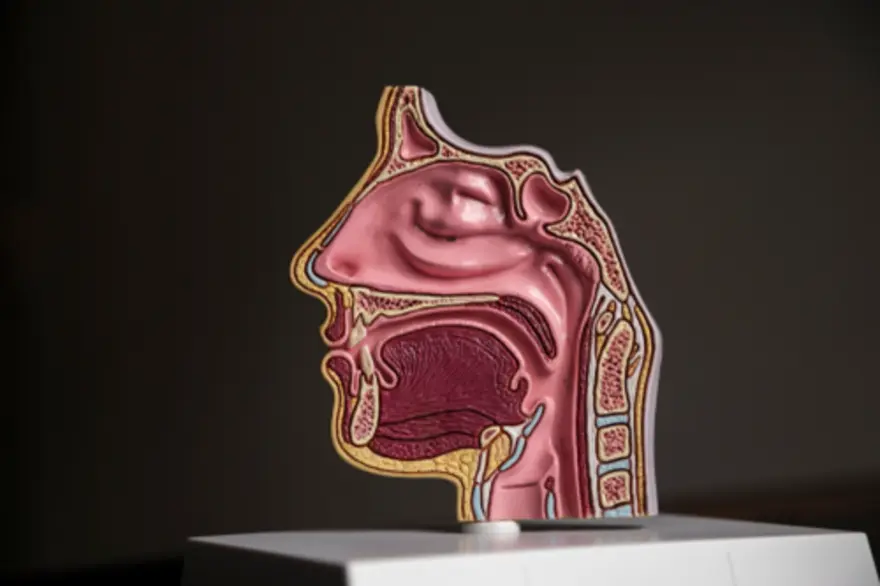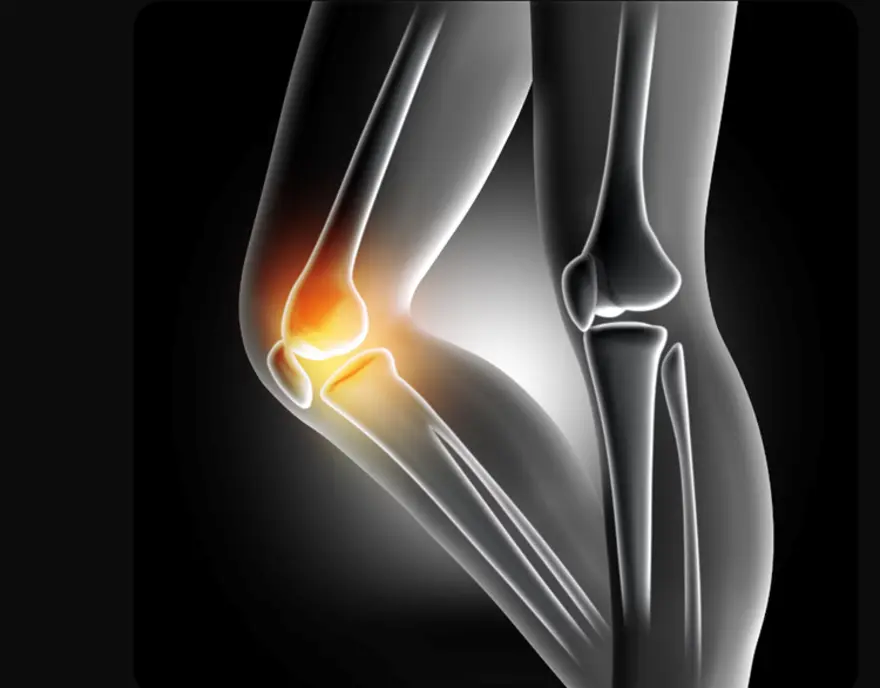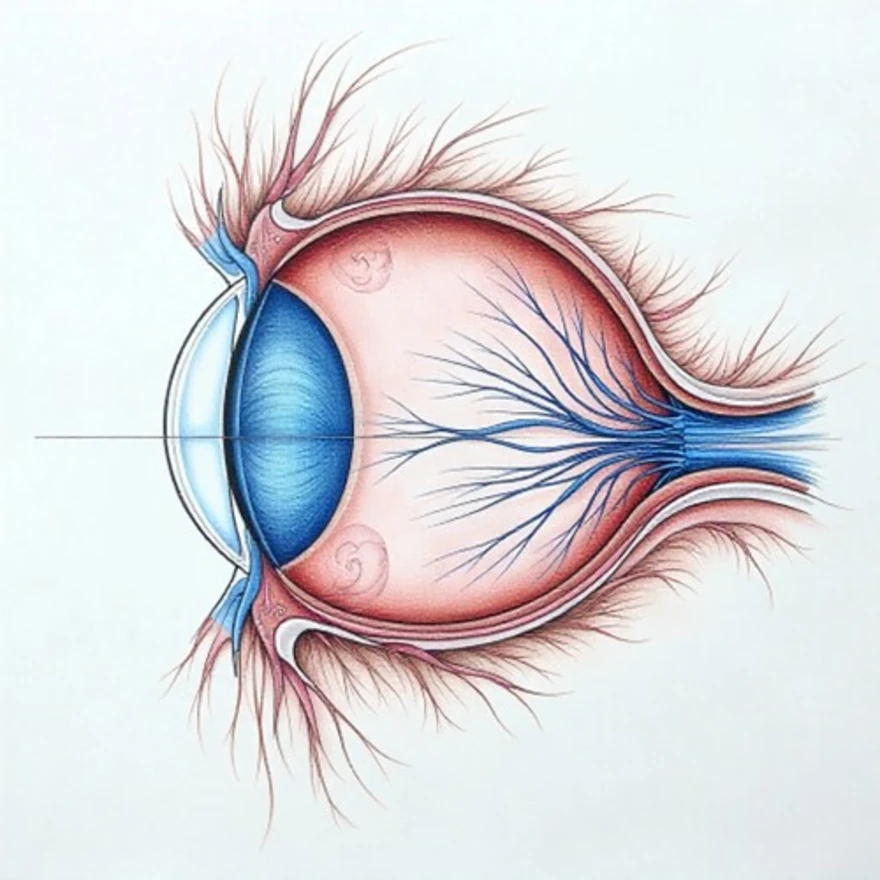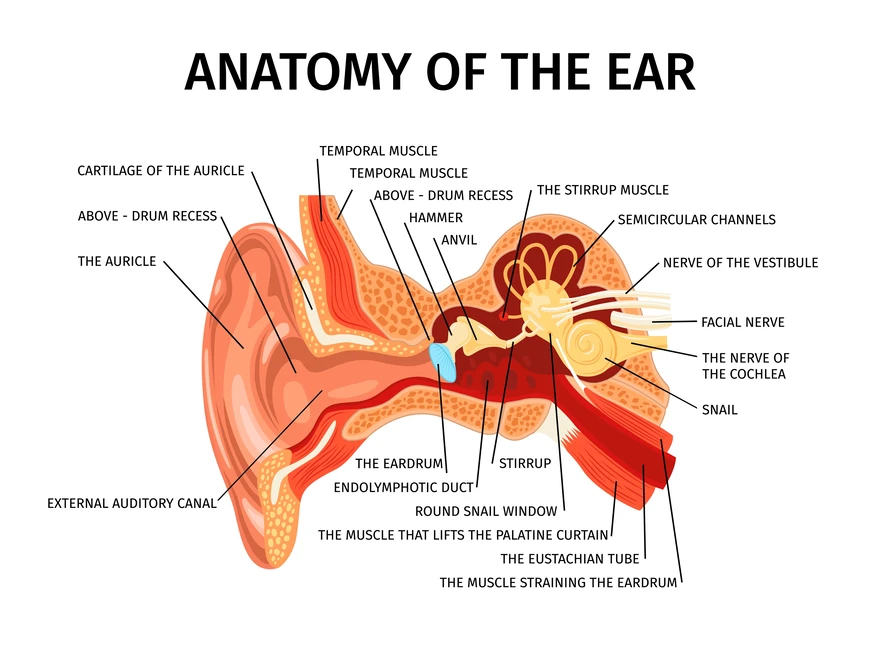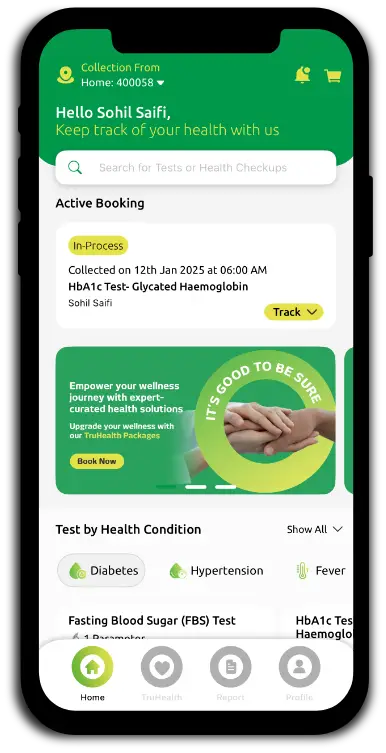Web Stories
Latest Blogs
Optic Neuritis: What It Is, Signs to Watch & Treatment Paths
What is Optic Neuritis? Optic neuritis is an inflammatory condition affecting the optic nerve—the vital bundle of nerve fibers that transmits visual information from your eye to your brain. Inflammation damages the protective myelin sheath surrounding these nerve fibers, disrupting their ability to transmit clear visual signals. This condition typically affects one eye, though both eyes can be involved in some cases. The inflammation prevents your optic nerve from functioning properly, leading to sudden vision changes ranging from mild blurring to temporary blindness in the affected eye. According to the American Academy of Ophthalmology, optic neuritis most commonly affects adults between ages 20 and 40, occurring more often in women than in men. The condition is notable because it can be the first sign of an underlying neurological condition such as multiple sclerosis. The inflammation can develop rapidly, with symptoms typically worsening over hours to days before potentially beginning to improve. Understanding what triggers optic neuritis is crucial for proper treatment. The condition occurs when your body's immune system mistakenly attacks the myelin sheath protecting your optic nerve fibers. Without this protective coating, nerve signals become scrambled or blocked entirely, resulting in the vision problems characteristic of this condition. Symptoms of Optic Neuritis • Sudden vision loss - Ranging from mild blurring to severe vision impairment or, rarely, temporary blindness in one eye • Eye pain - Particularly sharp, aching pain that worsens when you move your eyes in any direction • Colour vision changes - Colours appearing washed out, dull, or less vibrant than normal • Central vision problems - Difficulty seeing objects directly in front of you, creating a dark or blurry spot in your central field of view • Abnormal pupil reactions - The affected eye's pupil may not respond normally to bright light • Visual field defects - Missing patches, dark spots, or blind areas in your vision • Pain behind the eye - Deep, aching discomfort that may persist even when your eyes are closed The progression of optic neuritis symptoms typically follows a predictable pattern. Vision problems often develop rapidly over 24-48 hours, reaching their worst point within the first week. Pain usually accompanies the vision loss and may be the first symptom you notice, especially when moving your eyes. Causes and Risk Factors Understanding the optic neuritis causes helps explain why this condition develops and who might be at higher risk. While the exact cause remains unknown in many cases, researchers have identified several key factors that can trigger this inflammatory condition. Multiple sclerosis (MS) is the most common underlying condition associated with optic neuritis. Studies show that about 50% of people who experience optic neuritis develop multiple sclerosis within 15 years. This autoimmune disease causes the body's immune system to attack the protective myelin coating around nerve fibers throughout the central nervous system. Autoimmune conditions beyond multiple sclerosis also increase your risk. Systemic lupus erythematosus (lupus) can trigger optic neuritis when the immune system attacks healthy tissue throughout the body, including the optic nerve. Other autoimmune diseases like neuromyelitis optica spectrum disorder (NMOSD) and sarcoidosis can also cause optic nerve inflammation. Infectious diseases represent another major category of optic neuritis causes. Viral infections, particularly those affecting the respiratory system, can trigger an inflammatory response that damages the optic nerve. Bacterial infections like syphilis, Lyme disease, and tuberculosis have all been linked to optic neuritis development. Even childhood diseases like measles and other viral infections can occasionally lead to optic nerve inflammation. Additionally, having a family history of multiple sclerosis or other autoimmune conditions increases your likelihood of developing optic neuritis. Previous viral infections, particularly respiratory illnesses, may also elevate your risk. Diagnosis of Optic Neuritis Detailed medical history - Your doctor will ask about your symptoms, when they started, how quickly they developed, and whether you have any family history of autoimmune diseases or neurological conditions. Comprehensive eye examination - This includes checking your visual acuity, colour vision, pupil responses, and examining the optic nerve using specialised instruments. Neurological assessment - Your doctor will test your reflexes, coordination, and other neurological functions to look for signs of underlying conditions like multiple sclerosis. Visual field testing - This computerised test maps your complete field of vision to identify any blind spots or areas of vision loss. Advanced imaging studies - MRI scans of your brain and optic nerves can reveal inflammation and help identify underlying neurological diseases. Early and accurate optic neuritis diagnosis is crucial because prompt treatment can significantly improve your visual outcomes and help prevent future episodes. Tests Used to Diagnose Optic Neuritis • Visual acuity testing - Measures how clearly you can see letters on an eye chart at various distances • Colour vision assessment - Uses specialised plates or computer tests to evaluate your ability to distinguish different colours • Pupillary light reflex testing - Checks how your pupils respond to bright light, looking for the characteristic Marcus Gunn pupil sign • Ophthalmoscopy - Allows direct visualisation of your optic nerve head to assess for swelling or other abnormalities • Optical coherence tomography (OCT) - Provides detailed images of your retinal nerve fibre layer to detect thinning or damage • Visual evoked potential testing - Measures the electrical activity in your brain in response to visual stimuli • MRI - The most important imaging test, revealing optic nerve inflammation and any brain lesions suggestive of multiple sclerosis Treatment Options for Optic Neuritis Effective optic neuritis treatment focuses on reducing inflammation, speeding recovery, and preventing future episodes. Treatment approaches vary depending on the underlying cause and severity of your condition. Corticosteroids represent the primary optic neuritis treatment for most patients. High-dose intravenous methylprednisolone is typically given for 3–5 days, sometimes followed by a short oral prednisone taper. These anti-inflammatory medications help reduce optic nerve swelling and may speed visual recovery, although they do not necessarily affect the final visual outcome. When optic neuritis is associated with multiple sclerosis, disease-modifying therapies (DMTs) are essential for preventing future relapses and slowing progression. These medications help prevent future relapses and slow the progression of neurological damage. Options include interferons, glatiramer acetate, and newer oral medications like fingolimod or dimethyl fumarate. For cases related to other autoimmune conditions like lupus, treatment focuses on managing the underlying disease. This might involve immunosuppressive medications like methotrexate, azathioprine, or mycophenolate mofetil, depending on your specific condition and overall health status. Infectious causes require targeted antimicrobial therapy. If syphilis is identified as the trigger, appropriate antibiotic treatment can help prevent further nerve damage. Similarly, Lyme disease-related optic neuritis responds to specific antibiotic regimens. Recovery and Prognosis • Timeline for improvement - Most people begin noticing visual improvement within 2-4 weeks of starting treatment, with continued recovery over several months • Extent of recovery - Some people may recover significant vision, though complete restoration isn't always possible • Residual effects - Some patients experience persistent colour vision problems or subtle visual field defects even after recovery • Risk of recurrence - Some people experience additional episodes, particularly those with underlying multiple sclerosis • Long-term monitoring - Regular follow-ups are essential to monitor recovery and detect any signs of associated neurological disease • Functional impact - Most people return to their normal daily activities, though some may need workplace accommodations or driving restrictions The speed and completeness of your recovery depend on several factors, including how quickly you received treatment, the severity of initial inflammation, and whether you have an underlying condition like multiple sclerosis. Can Optic Neuritis Lead to Permanent Vision Loss? Most individuals with optic neuritis do recover significant vision, though the extent varies considerably between patients. Permanent vision loss can occur, particularly when treatment is delayed or when extensive axonal damage has occurred before inflammation is controlled. Long-term visual outcomes depend on how quickly treatment begins, the severity of inflammation, and whether an underlying condition like multiple sclerosis is present. Even when some permanent changes occur, they're often subtle and don't significantly impact daily activities. Many people notice slight changes in colour perception or contrast sensitivity that don't interfere with driving, reading, or work-related tasks. What to Do If You Experience Vision Loss or Eye Pain? • Seek immediate medical attention - Contact your eye doctor or visit an emergency department if you experience sudden vision loss combined with eye pain • Don't wait to see if symptoms improve - Early treatment within the first few days of symptom onset offers the best chance for full recovery • Prepare for your appointment - Write down when symptoms started, how they've progressed, and any recent illnesses or medications you've taken • Bring a companion - Vision problems can make navigating medical appointments challenging, and having support helps ensure you don't miss important information • Ask about underlying conditions - If diagnosed with optic neuritis, discuss your risk for multiple sclerosis and other autoimmune diseases • Follow treatment recommendations - Take prescribed medications as directed and attend all follow-up appointments, even if your vision improves Conclusion Optic neuritis represents a serious but treatable condition that demands immediate medical attention when symptoms first appear. Understanding the warning signs: sudden vision loss, eye pain with movement, and colour vision changes, empowers you to seek timely care that can preserve your sight and identify underlying conditions like multiple sclerosis, lupus, or infectious diseases such as syphilis, Lyme disease, or measles complications. The journey from symptom onset through optic neuritis diagnosis and treatment requires patience and persistence, but the prognosis is generally encouraging. With proper optic neuritis treatment, including corticosteroids and management of underlying conditions, most people recover substantial vision within months. Advanced optic neuritis radiology and comprehensive testing help ensure accurate diagnosis and appropriate treatment planning. At Metropolis Healthcare, we support your journey towards better health with comprehensive diagnostic services designed around your needs. Our extensive portfolio of over 4,000 tests includes specialised neurological and autoimmune and neurological panels that help identify underlying causes of optic neuritis. Through our network of more than 220 laboratories and 4,600 service centres, we provide convenient access to accurate testing that guides effective treatment decisions. For comprehensive health monitoring and peace of mind, explore our diagnostic services today. Your vision and neurological health deserve the precision and care that advanced testing provides. FAQs Can Optic Neuritis Be Prevented? While you cannot completely prevent optic neuritis, maintaining good overall health, managing autoimmune conditions properly, and seeking prompt treatment for infections may reduce your risk of developing this inflammatory condition. Is Optic Neuritis Related to Multiple Sclerosis? Yes, optic neuritis is strongly associated with multiple sclerosis. Approximately 15-20% of people with multiple sclerosis first present with optic neuritis, and those with optic neuritis have increased risk for developing multiple sclerosis. How Long Does Recovery Take From Optic Neuritis? • Most people begin experiencing visual improvement within 2-4 weeks of starting treatment • Significant recovery typically occurs over 3-6 months • Complete recovery may take up to one year in some cases What Is the Role of Steroids in Treating Optic Neuritis? Corticosteroids like methylprednisolone reduce optic nerve inflammation and may speed visual recovery. While they don't necessarily improve final visual outcomes, they can help restore vision more quickly and reduce symptom severity. References https://my.clevelandclinic.org/health/diseases/14256-optic-neuritis https://eyewiki.org/Diagnostic_Approach_to_Atypical_Optic_Neuritis https://www.ncbi.nlm.nih.gov/books/NBK557853/ https://medlineplus.gov/ency/article/000741.htm https://jamanetwork.com/journals/jamaneurology/fullarticle/795756
Noonan Syndrome: Signs, Genetics & Living with the Condition
What is Noonan Syndrome? Noonan syndrome is a genetic disorder present from birth that affects multiple body systems. It is part of a group of conditions called RASopathies, caused by mutations in genes that control cell growth and development. It occurs equally in males and females across all ethnic backgrounds. The condition is marked by distinctive facial features, short stature and congenital heart disease, though the severity can range from mild to complex. Noonan syndrome genetics involves mutations in genes regulating the RAS–MAPK signaling pathway, which may be inherited or arise spontaneously, leading to both familial and isolated cases. According to StatPearls (NIH), Noonan syndrome is an autosomal dominant RASopathy characterised by age-dependent features including wide-set eyes, low-set ears, short stature, and pulmonary valve stenosis. It involves multiple organ systems and requires multidisciplinary, lifelong management including cardiac follow-up, growth monitoring, bleeding assessment, and genetic counselling. What Are the Symptoms of Noonan Syndrome? Noonan syndrome symptoms vary considerably between individuals, but certain patterns help healthcare providers recognise the condition. The most noticeable Noonan syndrome features typically include: • Wide-set, pale blue or light-coloured eyes with drooping eyelids • Low-set, backwards-rotated ears with thick outer rims • Broad or flattened nasal bridge • Short stature affecting approximately 70% of individuals • Congenital heart disease, particularly pulmonary valve stenosis • Webbed or shortened neck • Chest wall abnormalities affecting chest shape Physical Symptoms of Noonan Syndrome The physical manifestations of Noonan syndrome create a recognisable pattern that aids diagnosis. Key physical symptoms include: • Distinctive facial features becoming more apparent with age • Short stature often below the third percentile for age • Heart defects affecting 80-90% of individuals with Noonan syndrome • Chest deformities such as pectus excavatum or carinatum • Joint flexibility or contractures affecting mobility • Undescended testicles in males • Easy bruising and prolonged bleeding times Developmental Delays and Other Symptoms Beyond physical features, Noonan syndrome frequently affects development and learning. Common developmental symptoms include: • Speech and language delays requiring therapy support • Motor skill delays affecting sitting, walking, and coordination • Learning difficulties, particularly in mathematics and reading • Attention and behavioural challenges resembling ADHD • Hearing loss affecting communication development • Vision problems, including strabismus and refractive errors • Feeding and swallowing difficulties during infancy and early childhood How is Noonan Syndrome Diagnosed? Diagnosing Noonan syndrome involves assessing physical features, family history, and, when available, genetic testing. Paediatric geneticists often lead this process using established clinical criteria. Genetic testing is the gold standard for confirming Noonan syndrome, but in 15–20% of cases, diagnosis relies on characteristic clinical features when no pathogenic mutation is detected. Tests Used to Diagnose Noonan Syndrome Several diagnostic tests help confirm Noonan syndrome and assess its impact: Comprehensive physical examination focusing on characteristic features Genetic testing using targeted gene panels or whole exome sequencing Echocardiogram to evaluate heart structure and function Electrocardiogram to assess heart rhythm abnormalities Hearing and vision assessments Developmental and cognitive evaluations Blood tests to check for bleeding disorders Genetics and Inheritance of Noonan Syndrome Noonan syndrome follows an autosomal dominant inheritance pattern, meaning only one mutated gene copy is required to cause the condition. If a parent has Noonan syndrome, each child faces a 50% chance of inheriting the mutation. However, approximately 60% of cases result from spontaneous mutations with no family history. The condition involves mutations in genes regulating cellular signalling pathways essential for normal development. These genetic mutations in Noonan syndrome affect cellular communication, leading to the diverse symptoms observed in affected individuals. Key Genetic Mutations Associated with Noonan Syndrome Several genes contribute to Noonan syndrome, with mutations occurring at different frequencies: • PTPN11 gene mutations cause approximately 50% of cases • SOS1 gene mutations account for 10-15% of diagnoses • RAF1 gene mutations contribute to roughly 5% of cases • RIT1 gene mutations also cause about 5% of cases • Other genes, including KRAS, NRAS, and BRAF, each cause fewer than 5% of cases Living with Noonan Syndrome: Treatment and Care Living with Noonan syndrome requires comprehensive, multidisciplinary care to address the condition’s multiple aspects. Although no cure exists, effective treatments can manage symptoms and significantly improve quality of life. Treatment approaches focus on addressing specific complications as they arise. Early intervention services help children reach their developmental potential, whilst ongoing medical monitoring prevents or manages complications. Many individuals with Noonan syndrome lead fulfilling lives with appropriate support and treatment. Success in managing Noonan syndrome depends on establishing strong relationships with healthcare teams familiar with the condition's complexities and staying informed about treatment advances. Managing Heart Issues in Noonan Syndrome Congenital heart disease affects most individuals with Noonan syndrome, making ongoing cardiac care essential. Pulmonary valve stenosis represents the most common heart defect, potentially requiring surgical intervention or balloon valvuloplasty. Regular cardiac monitoring helps detect changes early, allowing timely treatment adjustments. Some individuals develop hypertrophic cardiomyopathy, which requires distinct management strategies, including medications and lifestyle modifications. Therapies for Developmental Delays Addressing developmental challenges requires coordinated therapeutic interventions: • Speech therapy to improve communication skills and language development • Occupational therapy to enhance fine motor skills and daily living abilities • Physical therapy to strengthen muscles and improve coordination • Educational support services to address learning difficulties • Behavioural interventions for attention and social challenges Noonan Syndrome and Long-Term Outlook The long-term outlook for individuals with Noonan syndrome varies depending on symptom severity and complications present. Many people with mild symptoms live normal lifespans with minimal medical intervention. However, those with significant heart defects or other complications require ongoing medical care. Mild curvature, typically up to about 30 degrees in any direction, is usually considered a normal anatomical variation. Such natural asymmetries often develop during puberty and are harmless unless they cause discomfort or interfere with sexual activity. Research continues to advance the understanding of Noonan syndrome genetics, potentially leading to more targeted treatments in the future. Support and Resources for Families Affected by Noonan Syndrome Families navigating Noonan syndrome benefit from comprehensive support networks: • Genetic counselling services to understand inheritance and family planning • Patient advocacy organizations providing information and community support • Educational resources helping families understand the condition • Support groups connecting families facing similar challenges • Financial assistance programs for medical expenses and therapies Conclusion Understanding Noonan syndrome helps families manage the condition with confidence. With expert genetic testing, continuous health monitoring, and the right therapies, many individuals with Noonan syndrome can lead healthy, fulfilling lives. At Metropolis Healthcare, our vast network of labs, 4,600+ service centres, and 10,000+ home-collection touchpoints across India makes advanced genetic testing convenient and reliable. Book a home sample collection today and get accurate diagnostics to guide better care decisions. FAQs What causes Noonan Syndrome? Noonan syndrome results from genetic mutations affecting cellular signalling pathways essential for normal development. These mutations can be inherited from parents or occur spontaneously during early development. Can Noonan Syndrome be treated? Whilst no cure exists for Noonan syndrome, many symptoms can be effectively managed. Treatments include heart surgery for congenital heart disease, growth hormone therapy, developmental therapies, and medications for specific complications. What are the signs of Noonan Syndrome in babies? Early Noonan syndrome features in babies include distinctive facial characteristics, feeding difficulties, heart murmurs, and developmental delays. Parents may notice wide-set eyes, unusual ear shape, or failure to thrive. How is Noonan Syndrome diagnosed in children? Diagnosis involves clinical evaluation of physical features, family history assessment, and genetic testing. Healthcare providers look for characteristic Noonan syndrome symptoms and may order additional tests to confirm the diagnosis. References: https://medlineplus.gov/genetics/condition/noonan-syndrome/ https://www.genome.gov/Genetic-Disorders/Noonan-Syndrome https://www.ncbi.nlm.nih.gov/books/NBK532269/ https://www.chop.edu/conditions-diseases/noonan-syndrome
Claudication: Leg Pain from Poor Circulation – Causes & Treatment
What is Claudication? Claudication is a symptom of poor circulation, characterized by leg pain, aching, or cramping during walking or exercise that eases with rest. This claudication meaning reflects a clear pattern: activity-triggered discomfort followed by relief when you stop. It occurs because narrowed or blocked arteries cannot supply enough oxygen-rich blood to working muscles, leading to claudication pain—most commonly in the calves, but sometimes in the thighs, buttocks, or feet—that can range from mild discomfort to pain severe enough to limit daily activities. Types of Claudication Understanding different types helps identify the underlying cause and appropriate treatment approach: • Vascular claudication: The most common type, caused by peripheral artery disease (PAD) when fatty deposits narrow the leg arteries • Neurogenic claudication: Results from spinal stenosis compressing nerves in the lower back • Venous claudication: Less common type caused by blood clots or severe varicose veins blocking blood return What Causes Claudication? Claudication primarily results from atherosclerosis, a condition in which fatty deposits (plaques) accumulate within arterial walls. These plaques gradually narrow blood vessels, reducing blood flow to leg muscles during activity. When muscles demand more oxygen during exercise, the narrowed arteries cannot supply enough blood, leading to claudication pain. Several factors contribute to arterial narrowing and the development of claudication. Smoking damages artery walls and accelerates plaque formation. Diabetes affects blood vessel health and increases the risk of atherosclerosis. High blood pressure and elevated cholesterol levels also promote arterial damage and plaque buildup. Age plays a significant role since arteries gradually lose elasticity over time. Men typically develop claudication earlier than women, though the risk equalises after menopause. A family history of heart disease or peripheral artery disease increases an individual's risk substantially. How is Claudication Diagnosed? Healthcare providers use systematic approaches to diagnose claudication accurately: Medical history review: Reviewing symptoms, walking limitations, and cardiovascular risk factors Physical examination: Checking leg pulses, skin temperature, and color changes Ankle-brachial index (ABI): Comparing blood pressure measurements between arms and ankles Exercise testing: Monitoring symptoms and blood flow during treadmill walking Imaging studies: Using ultrasound, CT, or MRI to visualise blood vessels Symptoms of Claudication Recognising claudication symptoms enables early intervention and treatment: • Cramping or aching pain in calves, thighs, or buttocks during walking • Muscle fatigue, tightness, or heaviness that develops with activity • Pain relief within minutes of stopping and resting • Consistent pain location that occurs at predictable walking distances • Progressive limitation in walking distance over time • Numbness or tingling sensations in affected legs • Cool skin temperature or pale appearance in the feet or legs As per Clinical Methods (3rd ed.) (NIH), claudication is a symptom of arterial insufficiency in the legs, defined as exercise-induced pain, cramping, or fatigue in a lower limb muscle group that is consistently relieved by a brief rest while standing. It typically follows a reproducible “walk → pain → rest → relief” pattern, with severity graded by walking distance before symptoms force the person to stop (mild: 2–3 blocks, moderate: 1–2 blocks, severe: <1 block). Diagnostic and Imaging Methods for Detecting Claudication Modern diagnostic techniques provide detailed information about circulation problems: • Doppler ultrasound: Non-invasive method showing blood flow patterns and blockages • CT angiography: Detailed imaging using contrast dye to visualise arteries • Magnetic resonance angiography: MRI-based technique without radiation exposure • Segmental pressure testing: Measuring blood pressure at multiple levels of the leg to localize blockages • Pulse volume recordings: Measuring blood flow changes throughout the cardiac cycle How is Claudication Treated? Claudication treatment focuses on improving blood flow, managing symptoms, and preventing disease progression. The approach typically begins with lifestyle modifications and may progress to medications or procedures based on symptom severity and response to initial treatments. Early intervention often prevents claudication from worsening and reduces complications like heart disease. Treatment success depends on addressing underlying causes while effectively managing symptoms. Many people experience significant improvement through comprehensive management approaches. Can claudication improve without surgery? Yes, many individuals achieve substantial symptom relief through lifestyle changes, exercise programs, and medications before considering surgical interventions. Lifestyle Changes for Claudication Lifestyle modifications form the foundation of claudication management: • Smoking cessation: Most important step, as smoking severely worsens circulation problems • Regular walking exercise: Gradually increasing distance despite initial discomfort • Diabetes management: Maintaining blood sugar levels within target ranges • Blood pressure control: Keeping readings below recommended thresholds • Cholesterol management: Following heart-healthy dietary patterns • Weight maintenance: Achieving and maintaining a healthy body weight Medications for Claudication Several medications help manage claudication symptoms and underlying conditions: • Antiplatelet agents: Aspirin or clopidogrel, preventing blood clots • cholesterol-lowering drugs: Statins reduce plaque formation and stabilize existing deposits • Blood pressure medications: Various classes controlling hypertension effectively • Cilostazol: Medication specifically improving walking distance and reducing claudication pain • Diabetes medications: Managing blood sugar levels to protect blood vessels Surgical Options for Claudication When lifestyle changes and medications don't provide adequate relief, surgical interventions may be considered. Angioplasty involves inserting a small balloon into narrowed arteries to widen them, often followed by stent placement to keep arteries open. This minimally invasive procedure typically requires only local anaesthesia and short recovery periods and high success rates. Bypass surgery creates alternate pathways around blocked arteries using grafts from other blood vessels, such as veins from the leg. While more invasive than angioplasty, bypass procedures often provide longer-lasting results for severe blockages. The choice of procedures depends on the characteristics of the blockage, overall health, and individual circumstances. Managing Claudication Long-Term Successful long-term management requires ongoing commitment and regular monitoring: • Regular medical follow-ups: Monitoring disease progression and treatment effectiveness • Continued exercise programs: Maintaining and gradually increasing activity levels • Medication adherence: Taking prescribed medications consistently as directed • Risk factor management: Ongoing attention to diabetes, blood pressure, and cholesterol • Foot care: Preventing infections and injuries that heal poorly with reduced circulation Can Claudication Be Prevented? Prevention strategies focus on maintaining healthy blood vessels and preventing the development of atherosclerosis. Never smoking or quitting smoking represents the most effective prevention measure. Regular physical activity, even moderate walking, helps maintain circulation and prevents artery narrowing. Managing chronic conditions like diabetes, high blood pressure, and elevated cholesterol significantly reduces claudication risk. Following A Mediterranean-style diet rich in fruits, vegetables, whole grains, and healthy fats supports vascular health. Maintaining a healthy weight reduces strain on the cardiovascular system and decreases the risk of peripheral artery disease. What role does family history play in claudication prevention? While you cannot change genetic factors, knowing family history helps identify increased risk and motivates earlier preventive measures. When Should You See a Doctor for Claudication? Recognising when to seek medical attention ensures timely diagnosis and treatment: • Persistent leg pain during walking that consistently improves with rest • Progressive walking limitation over weeks or months • Pain occurring at rest or during minimal activity • Non-healing wounds or sores on legs or feet • Significant color changes in the legs or feet • Severe pain that interferes with daily activities Conclusion Understanding claudication helps you recognise symptoms early and seek timely care, and the condition often responds well to lifestyle changes, medicines, and, when needed, medical procedures. Quitting smoking, staying active, and controlling diabetes and blood pressure can improve walking ability and long-term vascular health. At Metropolis Healthcare, our 4,000+ tests include specialised assessments for circulation problems, and with home sample collection across 10,000+ touchpoints, you can easily access precise diagnostics to manage and help prevent claudication. FAQs What are the early signs of Claudication? Early claudication signs include mild cramping or aching in leg muscles during walking that disappears within minutes of resting. Initially, symptoms may occur only with longer walks or on uphill terrain. The pain typically develops in the exact location each time and at consistent walking distances. Can Claudication go away on its own? Claudication rarely resolves spontaneously and typically worsens without treatment. However, symptoms can improve significantly through lifestyle modifications, particularly smoking cessation and regular exercise programs. Early intervention prevents progression and may lead to substantial symptom relief. How is Claudication different from Peripheral Artery Disease (PAD)? Claudication is a symptom of underlying circulatory problems, while peripheral artery disease describes the underlying condition causing reduced blood flow. Not everyone with peripheral artery disease experiences claudication symptoms, but claudication nearly always indicates underlying peripheral artery disease requiring medical attention. References: https://www.ncbi.nlm.nih.gov/books/NBK235/ https://www.ncbi.nlm.nih.gov/books/NBK430746/ https://medlineplus.gov/peripheralarterialdisease.html https://www.nhs.uk/conditions/peripheral-arterial-disease-pad/
Inner Ear: Anatomy, Function & Common Problems
What is the Inner Ear? The inner ear is the deepest and most complex part of your ear, located deep within the temporal bone of the skull. It contains fluid-filled chambers and delicate sensory receptors that convert sound vibrations into electrical signals for hearing and detect head movements to maintain balance and spatial orientation. The two main parts of the inner ear—the cochlea (for hearing) and the vestibular system (for balance)—work together to give you clear hearing, spatial awareness, and a steady sense of orientation, even while you sleep. Anatomy of the Inner Ear As per a 2015 Journal of Anatomy review (NIH), the human inner ear—occupying just over 150 mm³—consists of a coiled cochlea for hearing and a vestibular complex with three semicircular canals for balance. Its finely tuned structure enables sensitive sound detection and precise control of head and body orientation. • Cochlea: Spiral-shaped hearing organ where tiny hair cells convert sound vibrations into nerve signals. • Semicircular canals: Three fluid-filled loops that detect head rotation and help maintain balance. • Vestibule: Central chamber housing the utricle and saccule, which detect gravity and linear acceleration. • Membranous labyrinth: Delicate system of sacs and ducts filled with endolymph that houses hearing and balance receptors. • Vestibulocochlear nerve: Cranial nerve VIII that carries hearing and balance information from the inner ear to the brain. How Does the Inner Ear Work? Sound waves travel through the outer and middle ear to reach the inner ear, where the stapes bone presses on the oval window of the cochlea. This movement creates waves in the fluid inside the cochlea. These waves bend microscopic hair cells within the organ of Corti, generating precise electrical signals. These signals are then transmitted via the auditory nerve to the brain, where they are interpreted as sound. For balance, head movements cause fluid shifts within the semicircular canals and vestibule. Hair cells in these structures. These waves bend microscopic hair cells within the organ of Corti, generating precise electrical signals. The vestibular nerve then sends signals to the brain, which integrates this information with vision and muscle feedback to help you stay upright and coordinated. Functions of the Inner Ear Your inner ear performs several critical functions that you rely on every day: • Sound processing: Converts mechanical sound waves into electrical signals your brain can interpret as music, speech, and environmental sounds • Balance maintenance: Detects head rotation, linear movement, and gravitational forces to help you stay upright and coordinated • Spatial orientation: Provides your brain with constant updates about your body's position relative to your surroundings • Motion detection: Senses acceleration, deceleration, and changes in direction during movement Common Problems of the Inner Ear Several conditions can affect your inner ear and cause symptoms like dizziness, hearing changes, or imbalance: Hearing loss: Damage to the cochlea or the auditory nerve can cause mild to profound hearing difficulty. Ménière’s disease: Recurrent episodes of vertigo accompanied by hearing loss, tinnitus, and a sensation of fullness in the affected ear. Labyrinthitis: Inflammation of the inner ear that causes dizziness, imbalance, and sometimes hearing loss. Vestibular neuritis: Swelling of the vestibular nerve causes severe vertigo and balance problems without hearing loss. Tinnitus: Ongoing ringing, buzzing, or other phantom sounds in one or both ears. Benign paroxysmal positional vertigo (BPPV): Brief episodes of spinning dizziness triggered by specific head positions. Hearing Loss and the Inner Ear Most permanent hearing loss is sensorineural, meaning it arises from damage to the inner ear or the auditory nerve. Common causes include: Long-term exposure to loud noise Age-related degeneration of cochlear hair cells Inner ear infection or inflammation Certain medications that are toxic to the inner ear (ototoxic drugs) Genetic factors and congenital conditions can also cause inner ear disorders. Your doctor can recommend appropriate treatment options. Balance Disorders Related to the Inner Ear Balance problems can arise when the inner ear function is disturbed. Typical symptoms of inner ear problems affecting balance include: Dizziness or sensation that the room is spinning (vertigo) Unsteadiness while walking Nausea and vomiting during vertigo episodes Blurred vision when moving the head Feeling of pressure or fullness in the ear Diagnostic and Imaging Methods for Inner Ear Disorders Healthcare professionals use various tests to evaluate inner ear function and diagnose problems: Audiometry: Comprehensive hearing tests that measure your ability to hear different frequencies and volumes Electronystagmography (ENG) and Videonystagmography (VNG): These tests assess balance function by monitoring eye movements in response to various stimuli Vestibular evoked myogenic potentials (VEMP): Measures how well your balance organs respond to sound or vibration Magnetic resonance imaging (MRI): Provides detailed images of inner ear structures and surrounding nerves to identify tumours or structural abnormalities Computed tomography (CT) scans: Provide detailed images of the bony structures of the ear, helping detect fractures, malformations, or other abnormalities Otoscopy: Visual examination of the ear canal and eardrum to rule out external causes of symptoms Supporting blood tests (as advised): Tests such as complete blood count, blood sugar, lipid profile, thyroid function, vitamin B12, autoimmune markers, or infection markers may be ordered to detect systemic conditions contributing to inner ear disease. Treatment for Inner Ear Problems Treatment approaches for inner ear disease vary depending on the underlying cause and severity: Medications: Corticosteroids for inflammation, antivertigo medications (such as meclizine or dimenhydrinate) for dizziness, and antibiotics for bacterial infections Vestibular rehabilitation therapy: Specialised exercises designed to improve balance and reduce dizziness symptoms Hearing aids or cochlear implants: Assistive devices that help manage hearing loss when inner ear damage is permanent Canalith repositioning procedures: Manual techniques to treat BPPV by moving displaced crystals back to their proper position Lifestyle modifications: Low-salt diets for Ménière’s disease, stress management, and avoiding known triggers such as caffeine or alcohol Surgical interventions: Considered only for severe cases unresponsive to medical or rehabilitative therapies Sound therapy: Various approaches to manage tinnitus and improve hearing comfort Prevention of Inner Ear Issues While not all inner ear problems are preventable, you can reduce your risk by: Protecting your ears from loud noises with earplugs or earmuffs Keeping volume low when using headphones or earphones Treating ear infections early, as advised by your doctor Managing chronic diseases like diabetes, high blood pressure, and high cholesterol Avoiding unnecessary or prolonged use of medications known to be ototoxic (use only as prescribed by your doctor) Maintaining good hydration and a balanced diet Avoiding smoking and limiting alcohol intake When to See a Doctor Seek medical care promptly if you have sudden hearing loss, ongoing dizziness or severe vertigo, ear pain, constant tinnitus, or trouble maintaining balance, as these symptoms may signal inner ear problems that need urgent attention. Early evaluation helps prevent permanent damage and allows your doctor to identify the cause and start appropriate treatment. Conclusion Understanding your inner ear anatomy and function helps you recognise symptoms like tinnitus, dizziness, or hearing changes early and seek timely care. Because the inner ear controls both hearing and balance, disorders here can significantly affect daily life, but appropriate diagnosis and treatment often provide relief and prevent complications. At Metropolis Healthcare, our comprehensive portfolio of 4,000+ tests includes specialised assessments for hearing and balance disorders, supported by an extensive network of 220+ laboratories and 10,000+ touchpoints across India to bring reliable diagnostics closer to your home. By staying informed, acting early, and consulting healthcare professionals when symptoms arise, you can take charge of your inner ear health and protect your hearing and balance for years to come. FAQ What causes inner ear problems? Inner ear problems can result from various factors, including viral or bacterial infections, autoimmune disorders, head trauma, prolonged noise exposure, certain medications, ageing, and genetic conditions. Some conditions, like Ménière's disease, have unknown causes, whilst others, like BPPV, may develop when tiny crystals in your balance organs become displaced. Can the inner ear heal itself? The inner ear has limited self-healing ability because the delicate hair cells in the cochlea and balance organs cannot regenerate once damaged. However, some conditions, like viral labyrinthitis, may improve as inflammation subsides, and your brain can sometimes compensate for balance problems through adaptation. This is why early treatment is crucial for preserving inner ear function. How do doctors test inner ear function? Doctors use several methods to evaluate inner ear function: • Hearing tests (audiometry) to assess auditory function • Balance assessments using specialised equipment to measure vestibular responses • Imaging studies like MRI or CT scans to visualise inner ear structures • Physical examinations, including otoscopy and neurological assessments References: https://pmc.ncbi.nlm.nih.gov/articles/PMC4718163/ https://www.ncbi.nlm.nih.gov/books/NBK532978/ https://www.nidcd.nih.gov/health/balance-disorders
Broken Hand: What to Expect, Treatment Options & Healing Time
What is a Broken Hand? A broken hand occurs when one or more of the 27 bones in your hand sustain a fracture or crack. These bones include the metacarpals (palm bones) and phalanges (finger bones), each playing a vital role in hand function. Understanding hand fractures helps you appreciate why prompt treatment is essential. The severity of a broken hand varies significantly. You might experience a simple hairline crack that heals relatively quickly, or a complex fracture where bones shatter into multiple pieces. Some breaks remain aligned, while others become displaced, requiring immediate medical intervention to prevent permanent damage. Because of your hand’s intricate structure, these injuries can be particularly concerning. Each bone works together to provide the dexterity and strength you rely on daily. When a broken hand occurs, it affects not just the fractured bone but potentially surrounding tissues, nerves, and blood vessels. Causes of a Broken Hand Understanding how broken hands occur helps you recognise when medical attention is necessary. The most common causes include: • Falls and accidents: Landing on an outstretched hand often causes metacarpal or finger fractures • Direct impact injuries: Punching walls, doors, or other hard surfaces often causes "boxer's fractures" • Sports-related trauma: Contact sports, cricket, football, and cycling accidents commonly lead to hand injuries • Motor vehicle collisions: High-impact accidents can cause severe, complex broken hand injuries • Crush injuries: Heavy objects falling on hands or getting fingers caught in doors • Workplace accidents: Manufacturing, construction, and manual labor environments pose higher risks Certain factors increase your vulnerability to bone fractures. Age-related bone density loss makes older adults more susceptible to breaks from minor trauma. Additionally, conditions like osteoporosis significantly weaken bones, making them prone to fractures even during routine activities. Symptoms of a Broken Hand Recognising broken hand symptoms early ensures you seek appropriate treatment promptly. Key warning signs include: • Severe, persistent pain that worsens with movement or pressure • Visible swelling around the injury site, often extending into the fingers • Bruising and discoloration that may appear immediately or develop within a few hours • Obvious deformity where bones appear crooked or out of alignment • Limited mobility or complete inability to move the affected fingers • Numbness or tingling suggesting possible nerve involvement • Tenderness to touch around the fracture site • Audible cracking sound at the time of injury According to the American Society for Surgery of the Hand, a broken hand is a fracture of the metacarpal or phalanx bones, usually caused by impact, crush, or twisting injuries, leading to pain, swelling, and stiffness. Stable fractures are often treated with splints or casts, while unstable or severe fractures may need surgery with plates, screws, or pins, followed by hand therapy to restore movement. Types of Hand Fractures Different types of broken hand injuries require specific treatment approaches. Understanding these variations helps you anticipate your recovery journey: • Metacarpal fractures: Breaks in palm bones, with fifth metacarpal "boxer's fractures" being most common • Phalangeal fractures: Finger bone breaks affecting proximal, middle, or distal sections • Displaced fractures: Bone fragments move out of normal alignment, often requiring surgical correction • Non-displaced fractures: Cracks where bones remain properly positioned • Comminuted fractures: Severe breaks creating multiple bone fragments • Open fractures: Bone penetrates skin, creating infection risks requiring immediate treatment Each fracture type influences your broken hand healing time and treatment complexity. Simple, non-displaced breaks typically heal faster than complex, displaced fractures that require surgical intervention. How is a Broken Hand Diagnosed? Proper diagnosis ensures you receive appropriate treatment for your specific injury. Healthcare providers use systematic approaches combining clinical examination with advanced imaging techniques. During your initial assessment, doctors evaluate pain levels, patterns of swelling, and functional limitations. They test sensation, circulation, and movement while carefully examining for deformities or instability. This physical evaluation helps determine injury severity and guides further diagnostic steps. Your medical history provides crucial context. Doctors need to understand how the injury occurred, your pain levels, and any previous hand problems. This information helps them anticipate potential complications and plan optimal treatment strategies. Diagnostic Imaging Methods for Hand Fractures Accurate diagnosis relies on sophisticated imaging techniques that reveal fracture details: • X-rays: Standard first-line imaging showing bone alignment, fracture patterns, and displacement • CT scans: Detailed cross-sectional images for complex fractures requiring surgical planning • MRI scans: Soft tissue evaluation when ligament, tendon, or nerve damage is suspected • Ultrasound: Sometimes used for initial assessment in emergencies Most diagnoses of broken hands rely primarily on X-ray imaging. These images clearly show fracture lines, bone displacement, and healing progress during follow-up visits. Advanced imaging is used when initial X-rays don’t fully explain symptoms or when surgical planning requires detailed anatomical information. Treatment Options for a Broken Hand Treatment approaches depend on fracture severity, location, and your individual circumstances. Options range from conservative management to complex surgical procedures: • Immobilization: Splints or casts keep bones properly aligned during healing • Closed reduction: Non-surgical realignment of displaced bones under local anaesthesia • Surgical fixation: Internal plates, screws, or pins for complex or unstable fractures • Pain management: Medications to control discomfort during recovery • Infection prevention: Antibiotics for open fractures to prevent osteomyelitis complications A broken hand plaster or cast remains the cornerstone of conservative treatment. These devices maintain bone position while allowing natural healing processes to occur. Modern casting materials offer greater comfort and water resistance than traditional plaster options. For severe injuries, surgical intervention becomes necessary. Surgeons use various techniques, including internal fixation with metal hardware, external fixation devices, or bone grafting, for complex reconstructions. The goal remains restoring normal anatomy and function. Healing Time for a Broken Hand Understanding realistic expectations for broken-hand healing time helps you plan accordingly and avoid frustration during recovery. Most simple fractures heal within 3-6 weeks with proper treatment, though complete functional recovery often takes longer. Your broken hand recovery time depends on numerous factors. Simple, non-displaced fractures typically heal faster than complex fractures that require surgery. Age plays a significant role, with younger patients generally experiencing quicker bone healing than older adults. Complete recovery encompasses more than just bone healing. After cast removal, you'll need time to regain strength, flexibility, and coordination. This rehabilitation phase may extend your total recovery time to several months, particularly for complex injuries or if complications arise. What Factors Can Affect Healing Time? Several factors influence how quickly your broken hand heals: • Fracture severity and complexity: Simple cracks heal faster than shattered bones • Patient age: Younger individuals typically experience faster bone regeneration • Overall health status: Chronic conditions like diabetes can slow healing processes • Smoking status: Tobacco use significantly impairs bone healing and increases complications • Nutrition quality: Adequate protein, calcium, and vitamin D support optimal recovery • Compliance with treatment: Following medical advice regarding activity restrictions and follow-up care When Should You Seek Medical Help? Specific symptoms demand immediate medical attention to prevent serious complications: • Severe deformity or apparent bone displacement • Open wounds with visible bone fragments • Complete loss of sensation or circulation problems • Increasing pain despite appropriate pain management • Signs of infection, including fever, increased swelling, redness, or discharge • Worsening symptoms after initial treatment Rehabilitation After a Broken Hand Rehabilitation begins once your doctor confirms that adequate bone healing has occurred. This phase focuses on restoring normal hand function through targeted exercises and activities. Physical therapy typically starts with gentle range-of-motion exercises to prevent stiffness. As healing progresses, strengthening exercises help rebuild muscle mass lost during immobilisation. Occupational therapy may address specific functional tasks, such as writing, typing, or workplace activities. Your rehabilitation timeline varies based on injury severity and individual factors. Simple fractures may require only basic home exercises, while complex injuries need formal therapy programs extending over several months. Can You Exercise with a Broken Hand? Exercise during broken hand recovery requires medical supervision and gradual progression. Initially, avoid activities that stress the injured area to prevent complications in healing. Once your doctor approves gentle movement, specific exercises can actually promote healing by improving circulation and preventing stiffness. However, premature or excessive activity can disrupt bone healing and prolong recovery time. Focus on exercises that don't involve the injured hand while maintaining overall fitness. Walking, lower-body strengthening, and cardiovascular activities help preserve overall health during recovery. Conclusion A broken hand is a significant injury that needs timely medical care and active participation in recovery. While simple fractures may heal within a few weeks, complex injuries or those requiring surgery can take several months and often need regular physiotherapy. Recognising symptoms early, seeking prompt treatment, and strictly following medical advice and exercises go a long way in preventing long-term stiffness, pain, and other complications. At Metropolis Healthcare, we support your broken hand treatment with accurate and reliable diagnostics. Our portfolio of 4,000+ tests, along with advanced imaging and blood work, helps monitor healing progress and detect complications such as osteomyelitis. With 220+ laboratories and 10,000+ touchpoints across India, you can access quality testing from the comfort of your home. Book your home sample collection today to ensure your recovery is monitored with care and convenience. FAQs What should I do if I suspect a broken hand? If you suspect a broken hand, immediately immobilise the injury using a makeshift splint or sling. Apply ice wrapped in a cloth to reduce swelling, but avoid direct ice contact with skin. Seek medical attention promptly, as delays can complicate treatment and affect long-term outcomes. How long does a broken hand take to heal? Broken hand healing typically takes about 3–6 weeks for simple fractures, though full recovery, including rehabilitation, may extend for several months. Complex injuries requiring surgery often need longer healing periods, sometimes extending 3-6 months for full functional recovery. When is surgery needed for a broken hand? Surgery becomes necessary for displaced fractures, open wounds, multiple bone fragments, or injuries affecting joint surfaces. Your surgeon will recommend the best approach based on fracture pattern, your age, activity level, and overall health status. What are the signs that a broken hand is healing properly? Positive healing signs include: • Decreasing pain levels over time • Reduced swelling and improved appearance • Gradual return of sensation and circulation • Improved range of motion as approved by your doctor • X-ray evidence of bone healing progression What complications can arise from a broken hand? Potential complications include: • Infection, particularly osteomyelitis in severe cases • Permanent stiffness or reduced range of motion • Chronic pain affecting daily activities • Malunion, where bones heal in incorrect positions • Nonunion, where bones fail to heal properly • Nerve or blood vessel damage causing lasting problems References https://www.assh.org/handcare/condition/broken-hand https://www.chop.edu/conditions-diseases/hand-fractures https://www.assh.org/handcare/condition/hand-fracture https://www.nhs.uk/conditions/broken-finger-or-thumb/
Liver Spots (Age Spots): Causes, Prevention & Skin Care Tips
What are Liver Spots (Age Spots)? Liver spots, or solar lentigines, are flat, brown, black, or gray patches that appear on sun-exposed areas like the face, hands, shoulders, arms, and upper back. They have well-defined borders, uniform color, and a smooth, flat surface. Unlike melanoma, they usually remain consistent in size and shape over time. Liver spots are benign and pose no health risk, but if a spot changes in size, colour, or texture, you should consult a dermatologist, as some skin cancers can initially resemble age spots. As per a study in Experimental Dermatology (NIH), age spots are sun-induced lesions with roughly double the melanin and structural skin changes, mainly due to reduced melanin clearance rather than increased production. Common Causes of Liver Spots The primary cause of liver spots is prolonged exposure to ultraviolet (UV) radiation from the sun or tanning beds. Over decades, this exposure causes melanin—the pigment that gives your skin its colour—to clump together in certain areas, creating the characteristic dark patches. Several factors increase your likelihood of developing age spots. Fair-skinned individuals are particularly susceptible because they have less natural protection against UV rays. People over 50 are most commonly affected, though younger individuals who spend significant time in the sun may also develop these spots. A history of frequent sunburns significantly elevates your risk. Each sunburn damages skin cells and accelerates the appearance of liver spots. Additionally, past medical treatments involving UV radiation or phototherapy can contribute to their development. How to Prevent Liver Spots? Prevention remains the most effective approach to managing liver spots. Here are essential strategies to protect your skin: • Apply broad-spectrum sunscreen with SPF 30 or higher every day, even when it’s cloudy • Reapply sunscreen every two hours and immediately after swimming or sweating • Wear protective clothing, including wide-brimmed hats, long sleeves, and UV-blocking sunglasses • Seek shade during peak sun hours between 10 a.m. and 4 p.m. • Avoid tanning beds and sunlamps completely, as they emit concentrated UV radiation • Perform regular self-skin checks and schedule dermatologist exams for new or changing spots Treatment Options for Liver Spots Several liver spot treatment options can effectively reduce or eliminate existing age spots: • Prescription topical creams containing hydroquinone, tretinoin, or corticosteroids gradually lighten spots over several months • Laser therapy precisely targets excess melanin without damaging surrounding skin tissue • Chemical peels use controlled acids to remove damaged skin layers and promote new cell growth • Cryotherapy uses liquid nitrogen to freeze and destroy excess pigment cells • Microdermabrasion gently exfoliates the skin’s surface to gradually fade spots • Over-the-counter fade creams may provide modest improvements but typically require longer treatment periods When to See a Doctor About Liver Spots While liver spots are harmless, certain changes warrant immediate medical attention. Consult a dermatologist if you notice spots that change in size, shape, or color, develop irregular borders, or display multiple colours within the same place. Additional warning signs include itchy skin around the spots, tenderness, bleeding, or rapid growth. These changes could indicate melanoma or other serious skin conditions that require prompt evaluation and treatment. Regular skin examinations by a healthcare professional can help distinguish between benign age spots and potentially dangerous lesions. Early detection of skin cancer significantly improves the outcomes of age spot treatment. Skin Care Tips for Preventing Age Spots Consistent daily skincare habits can significantly reduce your risk of developing new liver spots: • Use gentle, non-irritating cleansers that won't damage your skin barrier • Moisturize regularly to support healthy skin barrier function and natural repair • Incorporate antioxidant-rich products like vitamin C serums to combat free radical damage • Avoid harsh scrubbing, which can irritate the skin and increase UV sensitivity • Choose skincare products with proven ingredients like niacinamide or alpha hydroxy acids • Maintain consistent sun protection as the foundation of any anti-ageing skincare routine How to Manage Liver Spots with Skincare A comprehensive skincare approach can help minimise the appearance of existing liver spots while preventing new ones. Daily sunscreen application remains crucial, as continued UV exposure will worsen existing spots and create new ones. Gentle exfoliation using alpha hydroxy acids (AHAs) can gradually improve skin tone and texture. However, avoid over-exfoliating, which can cause irritation and increased sun sensitivity. Always introduce new products gradually and monitor your skin's response. Natural Remedies for Liver Spots Some people explore natural approaches to managing age spots, though scientific evidence supporting these methods remains limited: • Aloe vera gel may provide modest skin-brightening effects • Vitamin C serums can support overall skin health and collagen production • Green tea extract contains antioxidants that may benefit skin appearance • Licorice root extract has mild skin-brightening properties • Lemon juice is sometimes used, but it can increase photosensitivity Liver Spots in Different Skin Types Age spots can affect all skin types, though they may appear differently depending on your natural colouring. People with fair skin typically develop more noticeable liver spots due to lower baseline melanin protection. Individuals with darker skin tones may develop spots that appear lighter or darker than the surrounding skin. Regardless of your skin type, consistent sun protection remains essential for prevention and management. Do Liver Spots Go Away on Their Own? Unfortunately, liver spots do not fade naturally over time. Once formed, these pigmented areas tend to persist or even become more prominent with continued sun exposure and ageing. Without intervention, existing age spots typically remain stable or gradually darken. This is why early prevention with consistent sun protection is far more effective than treating established spots later. Conclusion Understanding liver spots empowers you to make informed decisions about prevention and treatment. While these spots are harmless, taking proactive steps to protect your skin can prevent their formation and maintain healthier skin throughout your life. At Metropolis Healthcare, we support your journey towards better health awareness through comprehensive diagnostic services. With over 4,000 advanced tests available through our network of 220+ laboratories and 10,000+ touchpoints across India, we make health monitoring accessible and convenient. Our home sample collection service lets you access essential health screenings, including those that monitor conditions such as jaundice and liver disease, from the comfort of your home. For personalised health insights and professional guidance, consider booking a comprehensive health check-up today. FAQs Can liver spots be removed? Yes, various liver spot treatment options can effectively remove or significantly lighten these spots. Professional treatments like laser therapy, chemical peels, and prescription creams offer the best results, though complete removal isn't always guaranteed. Are liver spots dangerous? Liver spots themselves are completely harmless and pose no health risks. However, because some skin cancers can initially resemble age spots, it's important to have any changing or suspicious spots evaluated by a dermatologist. How long does it take for liver spots to fade? Treatment timelines vary significantly depending on the method used. Topical treatments may show initial results within 2-3 months, while professional procedures might provide faster results but require multiple sessions. Complete fading can take 6-12 months or longer. Can I get liver spots even if I don't tan? Absolutely. Liver spots develop from cumulative UV exposure over time, not from your skin's tanning response. Fair-skinned individuals who burn rather than tan are actually at higher risk for developing these spots. References https://pmc.ncbi.nlm.nih.gov/articles/PMC5342934/ https://medlineplus.gov/ency/article/001141.htm https://www.health.harvard.edu/a_to_z/age-spots-solar-lentigo-liver-spots-a-to-z
International Mind Body Wellness Day: Health Tests That Support Mental & Physical Well-Being
What is International Mind Body Wellness Day? International Mind Body Wellness Day is observed annually on January 3rd, highlighting the vital connection between mental and physical health. This awareness day encourages people worldwide to reflect on overall well-being and adopt self-care practices that nurture both mind and body. The day draws on ancient holistic healing traditions and modern scientific research confirming that thoughts, emotions, behaviors, and physiology are deeply interconnected. International Mind Body Wellness Day 2026 will mark another opportunity for individuals to embrace mindfulness, movement, and healthy lifestyle practices that promote comprehensive wellness. Why Mind–Body Health Matters More Than Ever Constant connectivity, work pressures, social media exposure, sleep deprivation, and sedentary habits have led to rising rates of chronic stress, anxiety, depression, and lifestyle-related diseases. According to the World Health Organisation, depression affects over 280 million people globally, while cardiovascular disease remains the leading cause of death worldwide. These conditions often occur together, creating a cycle where physical illness worsens mental health and vice versa. Chronic stress activates the hypothalamic-pituitary-adrenal axis, raising cortisol levels and blood pressure while disrupting immune, metabolic, and digestive functions. Over time, this increases the risk of cardiovascular disease, metabolic syndrome, depression, anxiety, and cognitive decline. Focusing on mind-body health awareness through stress management and preventive healthcare helps break this cycle and improve quality of life. How Mental and Physical Health Are Connected The brain and body communicate constantly through the nervous, endocrine, and immune systems. Your emotions and thoughts directly influence physiological responses like heart rate, hormone levels, and inflammation markers, while physical illness affects mood and cognitive function. Research shows that chronic psychological stress and depression are linked to increased inflammation, disrupted cortisol rhythms, elevated blood pressure, and weakened immunity. Gastrointestinal issues and altered gut bacteria can influence mood and contribute to anxiety and depression, while stress often worsens digestive symptoms. Similarly, regular physical activity, adequate sleep, balanced nutrition, and treatment of medical conditions are linked to reduced anxiety and depression, better cognitive performance, and improved resilience. Role of Preventive Health Tests in Mind–Body Wellness Preventive health tests play a crucial role in maintaining mind-body wellness by detecting risk factors and early disease before major symptoms develop. Regular screening allows you and your healthcare provider to intervene early with lifestyle changes, counselling, or medication when needed. Many people don't realise that physical conditions like thyroid dysfunction, anaemia, vitamin deficiencies, or sleep disorders can cause symptoms that mimic anxiety or depression. Key Health Tests That Support Mental & Physical Well-Being A comprehensive mind-body wellness approach combines mental health assessments, metabolic and cardiovascular tests, and lifestyle-related evaluations. For mental health, validated questionnaires assess depression, anxiety, and stress levels, while targeted medical tests can reveal physical causes of psychological symptoms. Physical health screenings focus on cardiovascular and metabolic risks that strongly impact mental health, including blood pressure, cholesterol, and blood sugar levels. Lifestyle assessments examine sleep quality, exercise habits, substance use, and stress coping behaviours, highlighting practical areas for improvement. Mental & Stress-Related Health Tests Stress-Related Tests: Include Adrenaline (Epinephrine), Noradrenaline (Norepinephrine) Plasma Tests, and neurotransmitter assays such as Dopamine ELISA Plasma Test for evaluating stress and mood regulation. Substance Use Screening: Includes the Allergy Drug Panel (Comprehensive – 35 Drugs) or Drugs of Abuse Panel (12 Drugs, Urine), which helps identify risky drug use patterns that commonly coexist with and worsen mental health conditions. Thyroid function tests: Includes Thyroid Profile Test or Thyroid Comprehensive Profile - 1 to diagnose hypothyroidism and hyperthyroidism that can cause depression, anxiety, irritability, fatigue, and cognitive problems. CBC (Complete Blood Count) Test: Detects anaemia, infections, or blood disorders that can contribute to fatigue, low energy, and impaired concentration. Vitamin B12 Test: Low B12 can cause fatigue, memory issues, irritability, and depression-like symptoms alongside neurological problems. Vitamin D Test: Vitamin D deficiency is associated with fatigue, musculoskeletal pain, and increased risk of depression. Physical Health & Metabolic Balance Tests Blood pressure measurement: Elevated blood pressure increases the risk of heart disease, stroke, and kidney disease, and can be worsened by chronic stress. Lipid Profile: Tests such as Lipid Profile – Maxi, Lipid Profile – 2, or Lipid Profile – 3 (Non-Fasting) detect dyslipidemia, which increases cardiovascular disease risk. Lifestyle factors and some psychiatric medications can also affect lipid levels. Diabetes Risk Assessment Profile Test: Screens for prediabetes and diabetes; high blood sugar is linked to fatigue and higher rates of depression. Liver Function Test (LFT): Monitor for fatty liver disease, alcohol-related damage, or medication side effects that affect energy and metabolism. Kidney Function Test (KFT): Assess kidney health, which can be affected by hypertension and diabetes; kidney disease may cause fatigue and mood symptoms. Lifestyle & Holistic Wellness Tests Sleep quality assessments: Questionnaires or sleep diaries evaluating sleep duration, quality, and nighttime awakenings that significantly impact mental health. Stress and burnout evaluations: Tools used by clinicians to assess chronic stress levels and coping mechanisms affecting overall health. Physical fitness assessments: Evaluate cardiovascular fitness, muscular strength, and flexibility to guide personalized exercise recommendations for both mental and physical health. Who Should Consider These Wellness Tests? Adults experiencing persistent fatigue, mood changes, or unexplained physical symptoms. Individuals with a family history of mental health conditions or chronic diseases. People who are under chronic stress from work, relationships, or life circumstances. Those with existing mental health conditions require comprehensive care. Anyone interested in preventive healthcare and early disease detection. When is the Right Time to Get Tested? Annual wellness visits: Comprehensive screenings as part of routine preventive care. When symptoms arise: New or persistent physical or mental health concerns warrant evaluation. Before major life changes: Health assessments can help manage stress and ensure resilience during transitions such as career changes, relocations, or relationship adjustments. Family history considerations: Earlier or more frequent testing may be recommended based on genetic risk factors. How Often Should You Monitor Mind–Body Health? Regular monitoring frequency depends on your individual risk factors and health status. Most adults benefit from annual comprehensive wellness testing, including mental health screening and basic metabolic panels. However, those with existing conditions or higher risk factors may need more frequent monitoring. Simple Lifestyle Tips to Support Mind–Body Wellness Aim for 7-9 hours of sleep each night and maintain a consistent sleep schedule. Try meditation, deep breathing, yoga, or other relaxation techniques daily. Stay physically active—include both cardiovascular exercise and strength training in your weekly routine. Focus on whole foods, fruits, vegetables, lean proteins, and healthy fats. Maintain social connections and seek support when needed. Limit alcohol and avoid smoking. Schedule regular health checkups. Take a Step Toward Holistic Health This Mind Body Wellness Day International Mind Body Wellness Day reminds us that optimal health requires attention to both mental and physical well-being. By understanding the connections between your mind and body, you can make informed decisions about your health and take proactive steps toward comprehensive wellness. Consider International Mind–Body Wellness Day 2026 your opportunity to prioritize holistic health through preventive care. Whether you're dealing with specific symptoms or simply want to optimise your wellness, the right combination of health tests can provide valuable insights into your overall health status. At Metropolis Healthcare, we understand the importance of comprehensive health monitoring for your mind-body wellness journey. Our extensive portfolio of over 4,000 tests includes specialised panels to support your holistic health goals. With our convenient home sample collection service spanning over 10,000 touchpoints across India, you can access accurate, reliable diagnostics in the comfort of your home, making preventive healthcare both accessible and stress-free. FAQs Why do we celebrate International Mind-Body Wellness Day? International Mind Body Wellness Day raises awareness that mental and physical health are interconnected, encouraging holistic approaches to wellness and self-care. How are mental and physical health connected? The brain and body communicate through the nervous, endocrine, and immune systems, and emotions affect physiology, while physical conditions influence mental well-being. Which blood tests help assess mental well-being? Thyroid function tests (TSH, free T4) Vitamin B12 and vitamin D levels Complete blood count to check for anaemia. Fasting glucose to assess metabolic health Can vitamin deficiencies affect mental health? Yes, deficiencies in vitamins B12, D, and folate can cause fatigue, depression-like symptoms, cognitive problems, and mood changes that improve with supplementation. How often should wellness tests be done? Most adults benefit from annual comprehensive wellness testing, though those with risk factors or existing conditions may need more frequent monitoring. Are preventive health tests useful even without symptoms? Yes, preventive tests can detect early disease, identify risk factors, and establish baseline health measurements before symptoms develop, enabling early intervention. References https://www.who.int/news-room/fact-sheets/detail/mental-disorders https://ddnews.gov.in/en/embracing-balance-international-day-for-mind-and-body-wellness-promotes-holistic-health/ https://www.ncbi.nlm.nih.gov/pmc/articles/PMC3341916/ https://www.heart.org/en/healthy-living/healthy-lifestyle/stress-management/stress-and-heart-health https://www.sleepfoundation.org/how-sleep-works/why-do-we-need-sleep https://www.ncbi.nlm.nih.gov/pmc/articles/PMC6170050/ https://www.who.int/health-topics/cardiovascular-diseases#tab=tab_1



